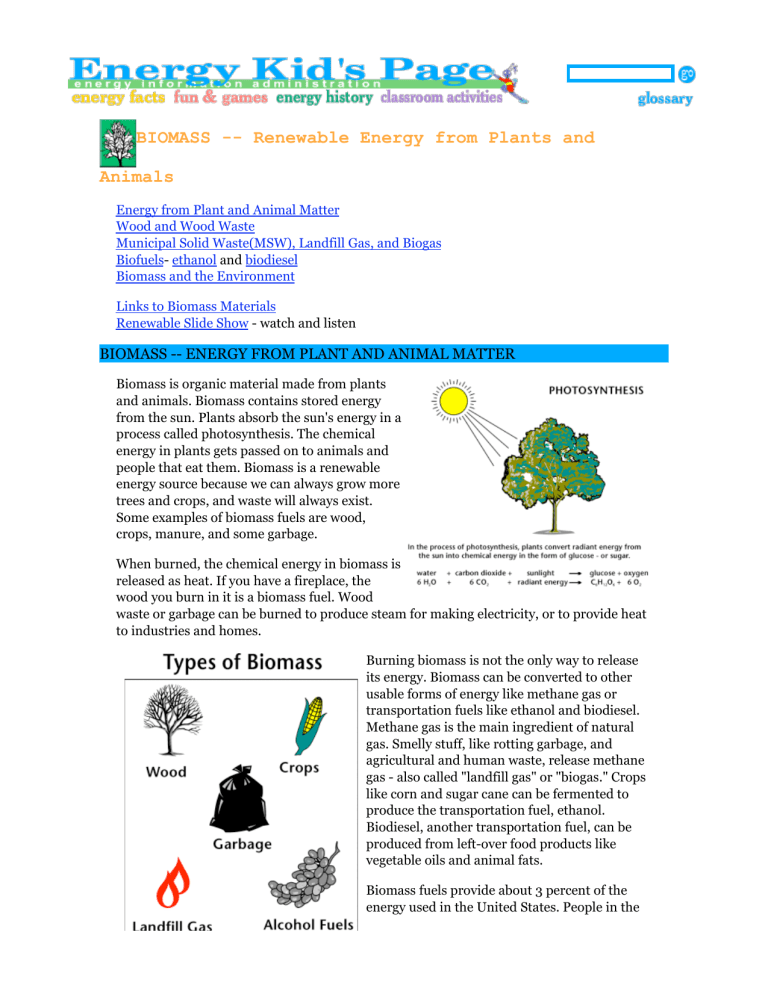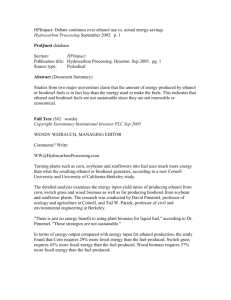
BIOMASS -- Renewable Energy from Plants and Animals Energy from Plant and Animal Matter Wood and Wood Waste Municipal Solid Waste(MSW), Landfill Gas, and Biogas Biofuels- ethanol and biodiesel Biomass and the Environment Links to Biomass Materials Renewable Slide Show - watch and listen BIOMASS -- ENERGY FROM PLANT AND ANIMAL MATTER Biomass is organic material made from plants and animals. Biomass contains stored energy from the sun. Plants absorb the sun's energy in a process called photosynthesis. The chemical energy in plants gets passed on to animals and people that eat them. Biomass is a renewable energy source because we can always grow more trees and crops, and waste will always exist. Some examples of biomass fuels are wood, crops, manure, and some garbage. When burned, the chemical energy in biomass is released as heat. If you have a fireplace, the wood you burn in it is a biomass fuel. Wood waste or garbage can be burned to produce steam for making electricity, or to provide heat to industries and homes. Burning biomass is not the only way to release its energy. Biomass can be converted to other usable forms of energy like methane gas or transportation fuels like ethanol and biodiesel. Methane gas is the main ingredient of natural gas. Smelly stuff, like rotting garbage, and agricultural and human waste, release methane gas - also called "landfill gas" or "biogas." Crops like corn and sugar cane can be fermented to produce the transportation fuel, ethanol. Biodiesel, another transportation fuel, can be produced from left-over food products like vegetable oils and animal fats. Biomass fuels provide about 3 percent of the energy used in the United States. People in the USA are trying to develop ways to burn more biomass and less fossil fuels. Using biomass for energy can cut back on waste and support agricultural products grown in the United States. Biomass fuels also have a number of environmental benefits. WOOD AND WOOD WASTE The most common form of biomass is wood. For thousands of years people have burned wood for heating and cooking. Wood was the main source of energy in the U.S. and the rest of the world until the mid-1800s. Biomass continues to be a major source of energy in much of the developing world. In the United States wood and waste (bark, sawdust, wood chips, and wood scrap) provide only about 2 percent of the energy we use today. About 84 percent of the wood and wood waste fuel used in the United States is consumed by the industry, electric power producers, and commercial businesses. The rest, mainly wood, is used in homes for heating and cooking. Many manufacturing plants in the wood and paper products industry use wood waste to produce their own steam and electricity. This saves these companies money because they don't have to dispose of their waste products and they don't have to buy as much electricity. The photograph to the right is of biomass fuel, probably wood chips, being stored and dried for later use in a boiler. MUNICIPAL SOLID WASTE, LANDFILL GAS, AND BIOGAS Another source of biomass is our garbage, also called municipal solid waste (MSW). Trash that comes from plant or animal products is biomass. Food scraps, lawn clippings, and leaves are all examples of biomass trash. Materials that are made out of glass, plastic, and metals are not biomass because they are made out of non-renewable materials. MSW can be a source of energy by either burning MSW in waste-to-energy plants, or by capturing biogas. In waste-to-energy plants, trash is burned to produce steam that can be used either to heat buildings or to generate electricity. In landfills, biomass rots and releases methane gas, also called biogas or landfill gas. Some landfills have a system that collects the methane gas so that it can be used as a fuel source. Some dairy farmers collect biogas from tanks called "digesters" where they put all of the muck and manure from their barns. Read about a field trip to a real waste-to-energy plant or learn about the history of MSW. BIOFUELS -- ETHANOL AND BIODIESEL "Biofuels" are transportation fuels like ethanol and biodiesel that are made from biomass materials. These fuels are usually blended with the petroleum fuels - gasoline and diesel fuel, but they can also be used on their own. Using ethanol or biodiesel means we don't burn quite as much fossil fuel. Ethanol and biodiesel are usually more expensive than the fossil fuels that they replace but they are also cleaner burning fuels, producing fewer air pollutants. Ethanol is an alcohol fuel made from the sugars found in grains, such as corn, sorghum, and wheat, as well as potato skins, rice, sugar cane, sugar beets, and yard clippings. Scientists are working on cheaper ways to make ethanol by using all parts of plants and trees. Farmers are experimenting with "woody crops", mostly small poplar trees and switchgrass, to see if they can grow them cheaply and abundantly. Most of the ethanol used in the United States today is distilled from corn. About 99 percent of the ethanol produced in the United States is used to make "E10" or "gasohol" a mixture of 10 percent ethanol and 90 percent gasoline. Any gasoline powered engine can use E10 but only specially made vehicles can run on E85, a fuel that is 85 percent ethanol and 15 percent gasoline. Biodiesel is a fuel made with vegetable oils, fats, or greases - such as recycled restaurant grease. Biodiesel fuels can be used in diesel engines without changing them. It is the fastest growing alternative fuel in the United States. Biodiesel, a renewable fuel, is safe, biodegradable, and reduces the emissions of most air pollutants. BIOMASS AND THE ENVIRONMENT Biomass can pollute the air when it is burned, though not as much as fossil fuels. Burning biomass fuels does not produce pollutants like sulfur, that can cause acid rain. When burned, biomass does release carbon dioxide, a greenhouse gas. But when biomass crops are grown, a nearly equivalent amount of carbon dioxide is captured through photosynthesis. Each of the different forms and uses of biomass impact the environment in a different way: Burning wood - Because the smoke from burning wood contains pollutants like carbon monoxide and particulate matter, some areas of the country won't allow the use of wood burning fireplaces or stoves on high pollution days. A special clean-burning technology can be added to wood burning fireplaces and stoves so that they can be used even on days with the worst pollution. Burning Municipal Solid Waste (MSW) or Wood Waste - Burning municipal solid waste (MSW or garbage) and wood waste to produce energy, means that less of it has to get buried in landfills. Plants that burn waste to make electricity must use technology to prevent harmful gases and particles from coming out of their smoke stacks. The particles that are filtered out are added to the ash that is removed from the bottom of the furnace. Because the ash may contain harmful chemicals and metals, it must be disposed of carefully. Sometimes the ash can be used for road work or building purposes. Learn more about MSW or waste-to-energy plants. Collecting landfill gas or biogas - Collecting and using landfill and biogas reduces the amount of methane that is released into the air. Methane is one of the greenhouse gases associated with global climate change. Many landfills find it cheaper to just burn-off the gas that they collect because the gas needs to be processed before it can be put into natural gas pipelines. Learn more about landfills . Ethanol- Since the early 1990s ethanol has been blended into gasoline to reduce harmful carbon monoxide emissions. Blending ethanol into gasoline also reduces toxic pollutants found in gasoline but causes more "evaporative emissions" to escape. In order to reduce evaporative emissions, the gasoline requires extra processing before it can be blended with ethanol. When burned, ethanol does release carbon dioxide, a green house gas. But growing plants for ethanol may reduce greenhouse gases, since plants use carbon dioxide and produce oxygen as they grow. Learn more on our Ethanol Page. Biodiesel- Biodiesel is much less polluting than petroleum diesel. It results in much lower emissions of almost every pollutant: carbon dioxide, sulfur oxide, particulates, carbon monoxide, air toxics and unburned hydrocarbons. Biodiesel does have nitrogen oxide emissions that are about 10 percent higher though. Blending biodiesel into petroleum diesel can help reduce emissions. Biodiesel contains almost no sulfur and can help reduce sulfur in diesel fuel used throughout the country. Learn more on our Biodiesel Page. Last Revised: November 2007 Sources: Energy Information Administration, Annual Energy Review 2006, June 2007. Energy Infromation Administration,Renewable Energy Annual 2005, July 2007. The National Energy Education Development Project, Intermediate Energy Infobook, 2006. The National Energy Education Development Project, Alternative Fuels: What Car Will You Drive?, 2004. U.S. Department of Energy, Energy Effciency and Renewable Energy, Clean Cities Fact Sheet- Low Level Ethanol Fuel Blends April 2005 EIA Main Home Page • Related Links • Kid's Page Privacy • Contact Us




